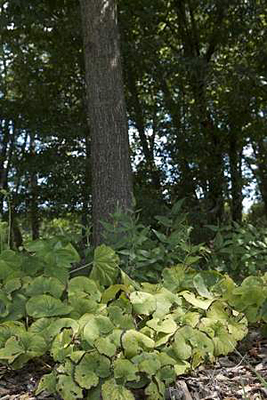
Diverse groundcovers
Ferns, ornamental grasses, herbaceous perennials, shrubs make good groundcovers
8:14 a.m., Aug. 31, 2011--A picture-perfect expanse of lawn has conveyed status since suburbs proliferated in the U.S. after World War II. In Europe, grass was a status symbol way earlier – in the 1600s English nobility maintained their estates’ lawns with grazing livestock and scythe-wielding peasants.
But, as status symbols go, grass is extravagant. It takes water to keep grass green; nationally, more than 50 percent of residential water usage is devoted to lawn care. It takes money, too. Americans spend $6 billion annually on their lawns, according to the Lawn Institute, a trade association. Some of that goes toward keeping the grass cut; some on pesticides and herbicides, which, if applied improperly, can run off into the water supply.
Campus Stories
From graduates, faculty
Doctoral hooding
But doing away with turfgrass has a downside. For recreational purposes, a green lawn has few equals. (It’s hard to play soccer or have a catch in a wildflower meadow.)
So should you try to achieve a green lawn? And if not grass, what should you plant on that one-quarter or one-half acre patch of soil surrounding your home?
It’s no conundrum to Sue Barton, ornamental horticulture specialist for UD Cooperative Extension. “Turfgrass is the only plant that can withstand regular traffic and there’s no groundcover that can replace it. Lawn is acceptable. However, most people don't need as much lawn as they have.”
“Homeowners should select areas that they want to maintain as lawn for entertainment, recreation or other reasons and the rest of the property should be something else,” she says. “That something else could be patio, meadow, forest or landscape beds.”
Barton’s yard is a bigger than most – 11 acres, several of which were mature woodland when she and her husband bought the property. In the non-wooded section, she has installed a three-acre wildflower meadow. She also a green lawn but it’s interspersed with other design features – including a patio and landscape beds. All told, turfgrass comprises less than 10 percent of the property.
Barton is a big fan of landscape beds and the building blocks of those beds – groundcovers. Many homeowners add new mulch to their landscape beds every year but Barton says they’re taking the wrong approach.
“Mulch as the ground layer in a landscape bed should only be a temporary situation until the groundcover takes over,” she says.
Groundcovers are a broad category of plants of many sizes, shapes and heights. On a mountain, trees are the groundcover, points out Barton. But in the average home landscape, groundcovers are typically a few inches to a few feet tall. They include a wide variety of plants, such as ferns, ornamental grasses, herbaceous perennials and even shrubs.
Groundcovers are seen as environmentally friendly as long as the plant’s requirements fit the existing conditions of the site. (In other words, don’t plant moisture-loving ferns in a bone-dry landscape bed.) When sited right, they require less fertilizer, pesticides and mowing than turfgrass. Plus, groundcovers support a greater diversity of wildlife than a monoculture of turfgrass.
Melinda Zoehrer, assistant director of the UD Botanic Gardens, and her husband Rick Darke, a landscape design consultant, use native groundcovers widely at their Landenberg, Pa., home. “Groundcover plants are essential in helping to knit the garden together and give it a sense of cohesiveness,” says Zoehrer. “They’re also invaluable in keeping down weeds, reducing evaporation and are far better to look at than mulch.”
The UD Botanic Gardens also features a wide variety of native groundcovers, particularly in the Herbaceous Garden and the Lepidoptera Trail. Look for white wood aster, a hardy, low maintenance plant with white flowers in mid- to late summer; wild ginger, which has heart-shaped leaves and can reach a foot high; Snow Flurry heath aster, a low, dense groundcover which sports a profusion of daisy-like flowers; and woodland geranium, a shade-loving plant with purple or violet flowers.
Groundcover lecture Sept. 6
Learn more about groundcovers at a lecture by Chanticleer horticulturist Dan Benarcik on Sept. 6. Benarcik will discuss groundcovers that are regionally appropriate and low maintenance. The lecture takes place at 7 p.m. at Townsend Hall in Newark and costs $5 for UD Botanic Gardens Friends; $10 for non-members. To register, email botanicgardens@udel.edu or call 831-2531.
Another good resource is a 17-page fact sheet about groundcovers compiled by Barton and UD Botanic Garden intern Rebecca Pineo.
UD Botanic Gardens plant sale
Native groundcovers and other perennials will be available at the UD Botanic Gardens’ fall plant sale Sept. 9, 4-7 p.m. and Sept. 10, 9 a.m.-2 p.m. at the Fischer Greenhouse, behind Townsend Hall in Newark. For more info, call 831-2531.
Article by Margo McDonough
Photo by Danielle Quigley








